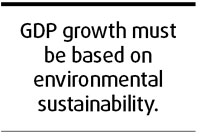Saying farewell to the GDP growth cult
Updated: 2008-02-04 07:13
The good news is in from Qinghai: Two years after the western province dropped GDP growth from its system for evaluating the performance of government officials in two of its prefectures, the ecological deterioration of the source area of China's three major rivers has begun to ebb.

According to local media reports, once vanished wetlands have reappeared, while water has returned to some of the dried-up lakes in the Sanjiangyuan, China's largest nature reserve, which sits at the headwaters of the Yangtze, Yellow and Lancang/Mekong rivers. The reserve covers an area of 318,000 sq km, slightly larger than Italy.
According to the provincial forestry administration, while desertification throughout Qinghai is still a problem, the annual rate at which the desert is spreading has dropped to 2,000 hectares from 13,000 hectares in the late 1990s.
It may take a while before the ecosystem in that part of the ecology-sensitive Qinghai-Tibet plateau is fully rehabilitated. Nevertheless, the initial effect of conservation efforts in the two Tibetan autonomous prefectures, Yushu and Golok, is promising.
More important is that Qinghai's move signals a departure from the "GDP cult", which sees economic growth as the only yardstick for development, even if it comes at the cost of the environment and people's welfare.
For years, this cult has dominated China's development pattern. In the fervor to pursue GDP growth, we have seen our mountains denuded by mining and other construction projects, cropland devastated by factories and urbanization and air and water polluted by heavy industry and human misconduct.
We have managed to unleash double-digit growth in our GDP, which is envied by many. Yet the cost we have paid for it is rather dear.
Among the 20 most polluted cities in the world last year as listed by the World Bank, 14 are in China. The worsening air quality has given rise to occurrences of lung cancer, which has become a top killer in the country. Also on the rise are TB (tuberculosis) and other diseases.
Pollution has aggravated the country's tight water supply and even caused the occasional drought. At 500 sections of China's nine major river systems that are monitored for water quality, only 28 percent have water suitable for drinking, while 31 percent have water with limited or no functional use. A sample survey of 118 cities in 2005 revealed that 97 percent of their groundwater was polluted to a varying degree, with 64 percent having seriously polluted groundwater.
Despite the hazards they have caused, many polluters manage to escape punishment because they are valued as "local economic pillars". Their contributions to the local GDP often override all other considerations.
That is why Qinghai's decision to delete GDP growth when evaluating government accomplishments, though in two prefectures only, is admirable. The move compels the local governments to shift its outlook on development from a pattern focused on GDP growth to one that is environmentally friendly and socially conscious.
Some might say it was not a big deal for Yushu and Golok to be exempted from GDP evaluations, since the secondary and tertiary industries are relatively small there. After all, the two prefectures, which sit at the headwaters of the three rivers, are known as "China's water tower" and have traditionally been pastures for nomadic Tibetans.
Still the habits of the GDP cult have led to overgrazing and gold mining, which have damaged vulnerable vegetation on the highlands, which sit at an average elevation of 4,000 m above sea level. If the livestock population and mining spree are not checked, ecological deterioration will choke any attempt at further development.
The people in Qinghai have learned enough lessons to reorient their development. GDP growth is not everything, but must be based on environmental sustainability and benefit people's welfare.
Of course abandoning the GDP cult does not mean completely forsaking GDP growth. To sustain the vitality of the world's most populous country, it is clear that we need to continue to expand our GDP to meet the growing needs of the people. But if our rivers and lakes all run dry, the air is befouled and soil made toxic as we pursue a high GDP growth rate, then we will not be far from doom. The GDP growth rate, however dazzling, will be meaningless.
There have been warning signs about the country's unsustainable mode of development. Aside from the moment when the water stopped flowing at the source area of the Yellow River in Qinghai years ago, the sudden explosion of foul-smelling algae that blanketed Taihu Lake in Jiangsu in late May last year and cut the drinking water supply to more than 2 million people in Wuxi city, a leading economic engine, sent shudders through the country.
Jiangsu has responded positively to the situation. Although maintaining the GDP growth rate remains a major tool for measuring officials' work, the provincial government is less fervent than it used to be. It has shut down more than 2,000 small chemical plants and built a 1 km wide green buffer zone around Taihu Lake. For the green belt, some 660 hectares of cropland will be returned to nature to reduce discharges of agricultural waste to the lake.
The move reflects Jiangsu's determination to repay its debt to nature. As a provincial leader has pledged, the lake must be cleaned even if it means a 15 percent downturn in the province's GDP.
I do not know if every province will have to wait until similar misfortunes strike before they abandon the GDP cult like Jiangsu and Qinghai have. But we now have the Scientific Outlook on Development, which emphasizes putting people first and the pursuit of comprehensive, coordinated and sustainable development. There is hope that old mindset, which puts the GDP growth rate above all else, will change.
The author is a council member of the China Society for Human Rights Studies
(China Daily 02/04/2008 page4)
|
|
|
|
|
|